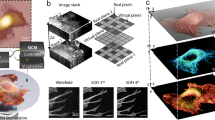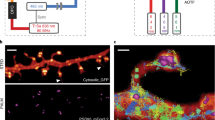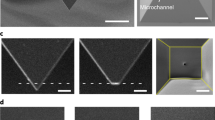Abstract
We describe hopping mode scanning ion conductance microscopy that allows noncontact imaging of the complex three-dimensional surfaces of live cells with resolution better than 20 nm. We tested the effectiveness of this technique by imaging networks of cultured rat hippocampal neurons and mechanosensory stereocilia of mouse cochlear hair cells. The technique allowed examination of nanoscale phenomena on the surface of live cells under physiological conditions.
This is a preview of subscription content, access via your institution
Access options
Subscribe to this journal
Receive 12 print issues and online access
$259.00 per year
only $21.58 per issue
Buy this article
- Purchase on Springer Link
- Instant access to full article PDF
Prices may be subject to local taxes which are calculated during checkout



Similar content being viewed by others
Change history
03 September 2009
NOTE: In the version of this paper originally published, references to previous work on pulse mode SICM should have been included (Mann et al. J. Neurosci. Methods 116, 113–117, (2002) and Happel et al. J. Microsc. 212, 144–151 (2003)). These references were removed during shortening of the paper for publication and have been added back to the PDF and HTML versions of this article. The pulse mode technique reported in these previous papers has conceptual similarity to our hopping mode SICM, in that distance feedback control is not continuous; thus, it also solves the problem of probe-sample collision for large cellular structures. However, the pulse mode technique is considerably slower owing to a different feedback mechanism and does not perform at nanoscale resolution.
References
Dufrene, Y.F. Nat. Rev. Microbiol. 6, 674–680 (2008).
Sun, P. et al. Proc. Natl. Acad. Sci. USA. 105, 443–448 (2008).
Hansma, P.K., Drake, B., Marti, O., Gould, S.A. & Prater, C.B. Science 243, 641–643 (1989).
Korchev, Y.E., Bashford, C.L., Milovanovic, M., Vodyanoy, I. & Lab, M.J. Biophys. J. 73, 653–658 (1997).
Shevchuk, A.I. et al. Angew. Chem. Int. Ed. Engl. 45, 2212–2216 (2006).
Mann, S.A., Hoffmann, G., Hengstenberg, A., Schuhmann, W. & Dietzel, I.D. J. Neurosci. Methods 116, 113–117 (2002).
Happel, P., Hoffmann, G., Mann, S.A. & Dietzel, I.D. J. Microsc. 212, 144–151 (2003).
Langer, M.G. et al. Ultramicroscopy 82, 269–278 (2000).
Langer, M.G. et al. Biophys. J. 80, 2608–2621 (2001).
Kachar, B., Parakkal, M., Kurc, M., Zhao, Y. & Gillespie, P.G. Proc. Natl. Acad. Sci. USA. 97, 13336–13341 (2000).
Stepanyan, R., Belyantseva, I.A., Griffith, A.J., Friedman, T.B. & Frolenkov, G.I. J. Physiol 576, 801–808 (2006).
van der Werf, K.O. et al. Appl. Phys. Lett. 65, 1195–1197 (1994).
Borgwarth, K., Ebling, D.G. & Heinze, J. Berichte der Bunsen-Gesellschaft Physical Chemistry Chemical Physics 98, 1317–1321 (1994).
Sun, P. & Mirkin, M.V. Anal. Chem. 78, 6526–6534 (2006).
Gorelik, J. et al. Proc. Natl. Acad. Sci. USA 99, 16018–16023 (2002).
Korchev, Y.E., Negulyaev, Y.A., Edwards, C.R., Vodyanoy, I. & Lab, M.J. Nat. Cell Biol. 2, 616–619 (2000).
Gorelik, J. et al. Biophys. J. 83, 3296–3303 (2002).
Acknowledgements
This study was supported by the UK Biotechnology and Biological Sciences Research Council and Medical Research Council to Y.E.K. and (BB/D01817X/1) to G.W.J.M. and T.G.S., and by the US National Organization for Hearing Research Foundation, the Kentucky Science and Engineering Foundation (KSEF-148-502-07-215) and National Institute on Deafness and Other Communication Disorders, National Institutes of Health (DC008861 to G.I.F.).
Author information
Authors and Affiliations
Contributions
P.N., C.L., A.I.S. and V.P.O. implemented experimental design into the hardware and the software; P.N., A.I.S., R.S., M.C. and S.H. performed the experiments; G.I.F., D.K., G.W.J.M., T.G.S., M.J.L., J.G. and Y.E.K. designed the study; P.N., G.I.F., D.K., G.W.J.M., T.G.S., M.J.L. and Y.E.K. wrote the paper.
Corresponding authors
Ethics declarations
Competing interests
P.N. has a consultancy agreement with Ionscope Ltd., a small start-up company selling scanning ion conductance microscopes. D.K., M.J.L., A.I.S. and Y.E.K. are shareholders of Ionscope Ltd.
Supplementary information
Supplementary Text and Figures
Supplementary Figures 1–3, Supplementary Methods (PDF 7112 kb)
Rights and permissions
About this article
Cite this article
Novak, P., Li, C., Shevchuk, A. et al. Nanoscale live-cell imaging using hopping probe ion conductance microscopy. Nat Methods 6, 279–281 (2009). https://doi.org/10.1038/nmeth.1306
Received:
Accepted:
Published:
Issue Date:
DOI: https://doi.org/10.1038/nmeth.1306
This article is cited by
-
Fast Scan mode of scanning electrochemical microscopy: In-situ characterization of phase transition and mapping the hydrogen evolution activity for MoS2
Nano Research (2023)
-
Intravital electrochemical nanosensor as a tool for the measurement of reactive oxygen/nitrogen species in liver diseases
Journal of Nanobiotechnology (2022)
-
Intrinsic cell rheology drives junction maturation
Nature Communications (2022)
-
Phycosphere pH of unicellular nano- and micro- phytoplankton cells and consequences for iron speciation
The ISME Journal (2022)
-
A subcellular cookie cutter for spatial genomics in human tissue
Analytical and Bioanalytical Chemistry (2022)



